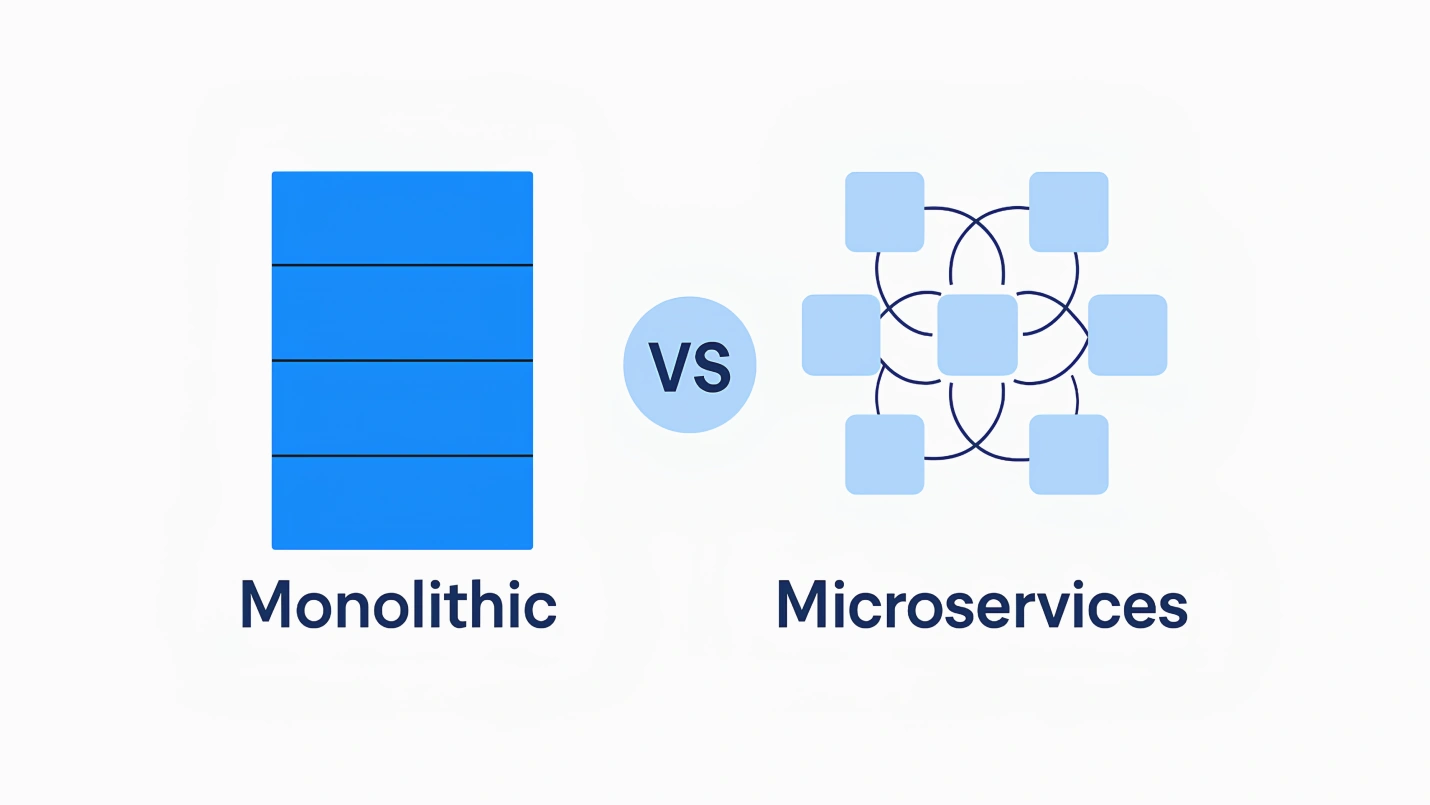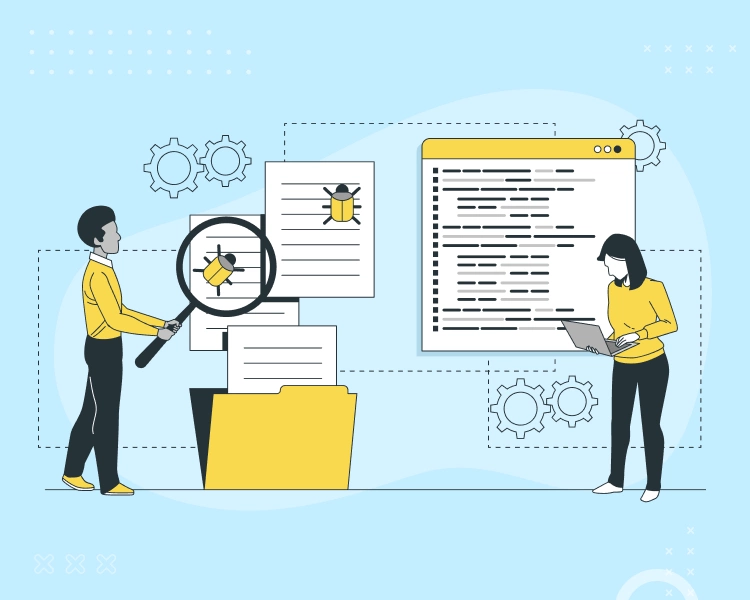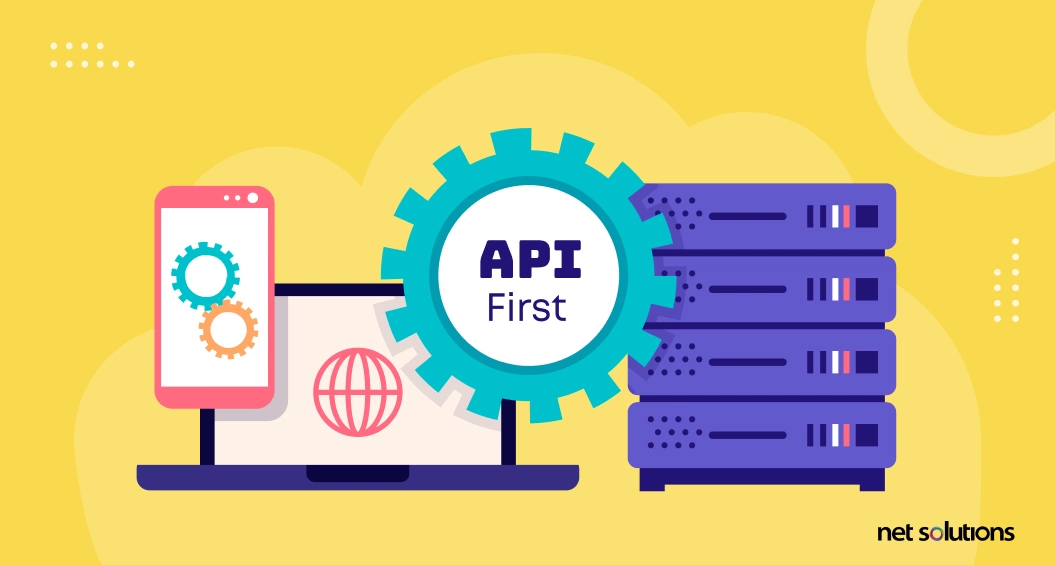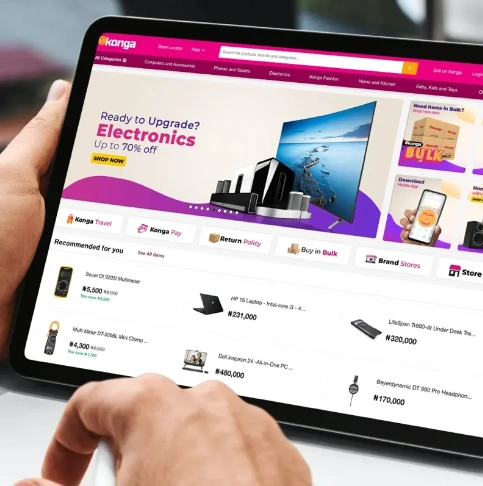In 2009, Netflix struggled to keep up with the increasing demand for its rapidly growing video streaming service. Hence, they decided to migrate from a monolith to a Microservices architecture.
The term Microservices didn’t exist back then, and the structure was yet to be famous. Despite this, Netflix became one of the first companies to migrate from a monolith to a cloud-based Microservices architecture.
Today, the video streaming service successfully operates with over a thousand independent Microservices. Despite engineers updating it thousands of times daily, it offers billions of users an uninterrupted viewing experience.
The drive to stay competitive in an ever-changing technology landscape has led to explosive growth in Microservices. Many organizations have adopted the microservice architecture to scale their business operations and remain competitive.
In this guide, we’ll learn the difference between monolithic and Microservices architecture, their pros and cons, and how to successfully migrate from monolithic to Microservices architecture.
What is Monolithic Architecture?
Monolithic architecture is the traditional approach to building a self-contained application, often called a “single-tier” application. Its name is derived from that of a monolith: a single massive stone or rock. In a monolithic or traditional architecture, the application contains three main components that together create one codebase:
- The user interface (UI): The frontend/presentation layer / client-side
- The business logic: The application and server-side programming (part of the backend)
- The data interface: The data access code that communicates the request to the database.
These three parts are managed and served from one giant code base connected to the database (sometimes called a fourth component).
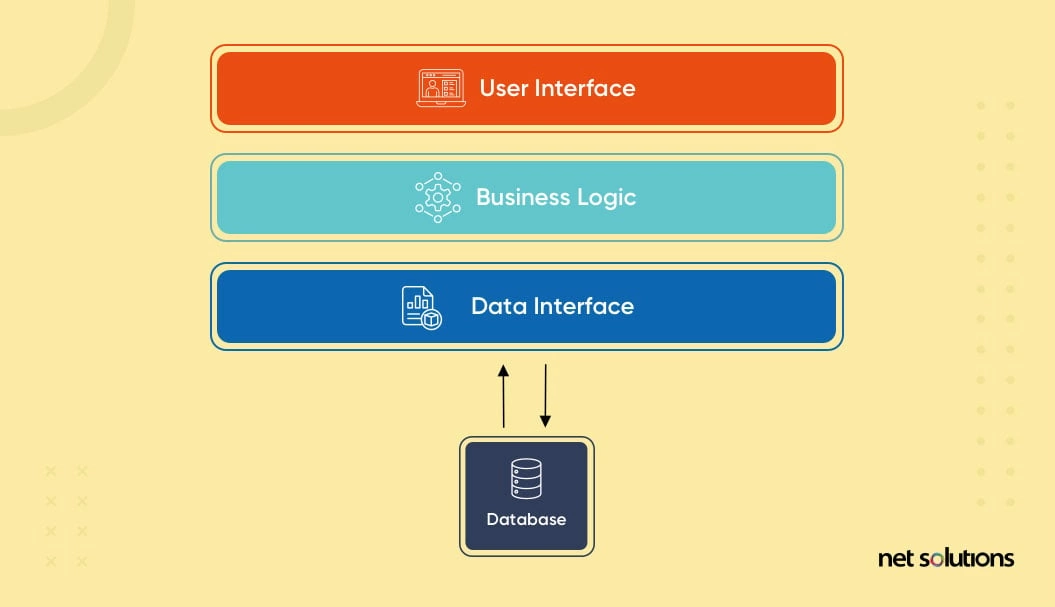
Monolithic Architecture Example
Monolithic Architecture Example Here’s how monolithic architecture would look for an eCommerce web application:
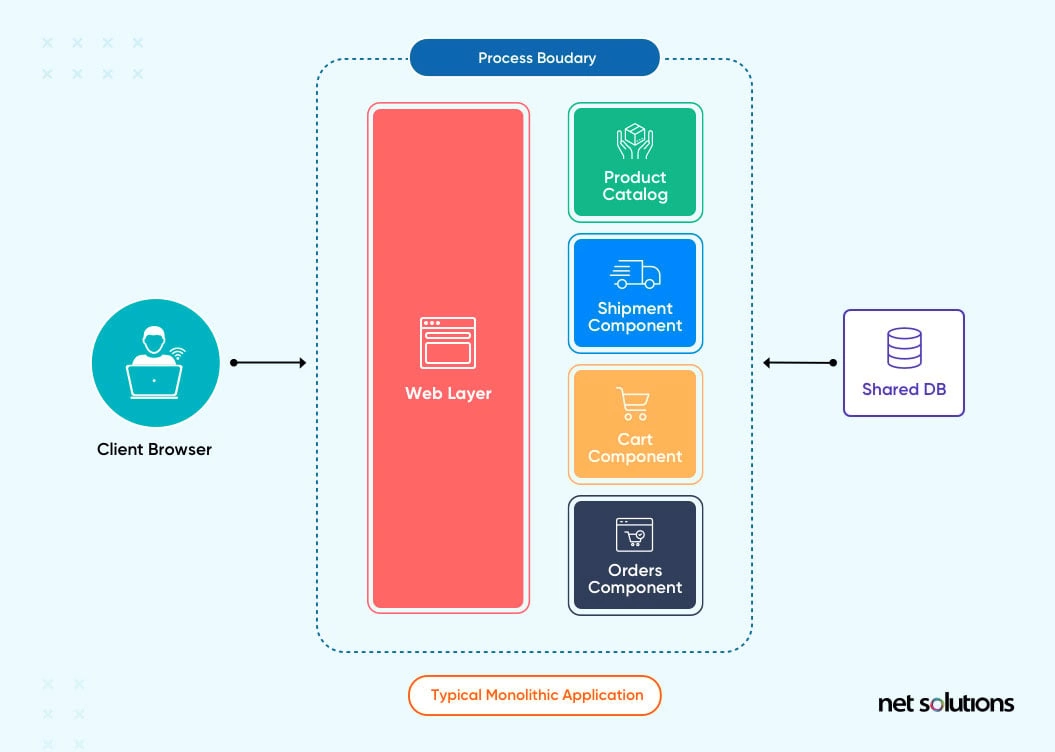
In this example, the client browser (represented as browser and device agnostic here) accesses the application, which displays the UI to interact with the product catalog and completes the order through communication with one or more databases shared by the entire monolithic application.
Advantages of the Monolithic Architecture
- Monolithic architecture is simple and easy to understand as it involves building the entire application in a single codebase with one set of languages and frameworks.
- Monolithic architecture typically performs better than distributed architecture as it does not require network communication between different components.
- Testing monolithic applications is easier as there is only one codebase to test. This way, you can easily ensure that all components work together correctly.
- The monolithic architecture supports vertical scaling to share the workload and improve performance.
- Monolithic architecture Eliminates cross-cutting concerns when an application operates across different modules (e.g., logging, performance monitoring).
Disadvantages of the Monolithic Architecture
- Updating to any part of the codebase impacts the monolithic architecture, requiring complete app recompilation.
- Any errors or server issues impact the entire application, impacting its overall reliability.
- Code reuse is limited, often only supported with shared libraries (leading to coupling issues).
- Changes to any part of the app code become expensive due to dependencies.
- The code base can become significant over time, marking it challenging to maintain and for new developers to contribute.
- Monolithic architecture does not support horizontal scaling (vertical scaling requires the whole application loads onto multiple servers), so everything scales when only a part of the application may be experiencing a large load.
- In monolithic architecture, you’re tied to a single technology stack for everything.
In short, monolithic apps are simple to develop but, over time, tend to become large. Hence, it isn’t easy to manage and update them.
What is Microservices Architecture?
Microservices architecture decouples the front end and back end of architecture, linking various independent services in the back end (microservices) to the front end via API. The microservices approach supports the flexibility to choose and scale services as needed.
An increase in digital transformations, a proliferation of connected devices, and a rise in the adoption of cloud-based solutions augment the growth of the global microservices architecture market.– Allied Research
Principles of Microservices
The correct Microservice principles can help developers build an application that performs and scales easily. The microservice architecture operates on the following principles:
- Service Independence: Each microservice should be independent of other microservices, with its database and business logic.
- Decentralization: Microservices architecture should be decentralized, with each service’s team responsible for its development, deployment, and maintenance.
- Agility: Microservices architecture should enable fast and flexible development, deployment, and scaling of individual services without affecting the entire system.
- Resilience: Microservices should be fault-tolerant, with each service able to handle errors and failures independently.
- Scalability: Microservices architecture should enable easy scaling of individual services to meet changing demands without affecting the entire system.
- Continuous Integration and Deployment: Microservices architecture should enable continuous integration and deployment, with each service being built, tested, and deployed independently.
- API-First Approach: Microservices architecture should follow an API-first approach, with each service exposing well-defined and documented APIs that other services can use.
However, you can achieve the best outcomes by focusing on these three best practices:
1. Single Responsibility
The single responsibility principle (SRP) in programming states that every module should have responsibility over only one part of the app, narrowly defined and encapsulated
2. Built Around Business Capabilities
Business logic is the core of microservices, with each service built around a business capability rather than a technical capability. Each business problem can be solved in a microservice that leverages its tech stack.
3. Design for Failure
Designing for failure means building resiliency into the app’s core. By defining boundaries around independent and encapsulated microservices, issues in one service should not affect other benefits. However, downtime is inevitable in every system, so designing for failure introduces how to degrade service if one or more components fail. For example, when Instagram is down (not fetching new content), it still supports browsing cached content.
What is an Example of Microservices?
Here’s an example of an eCommerce web app built on a microservices architecture:
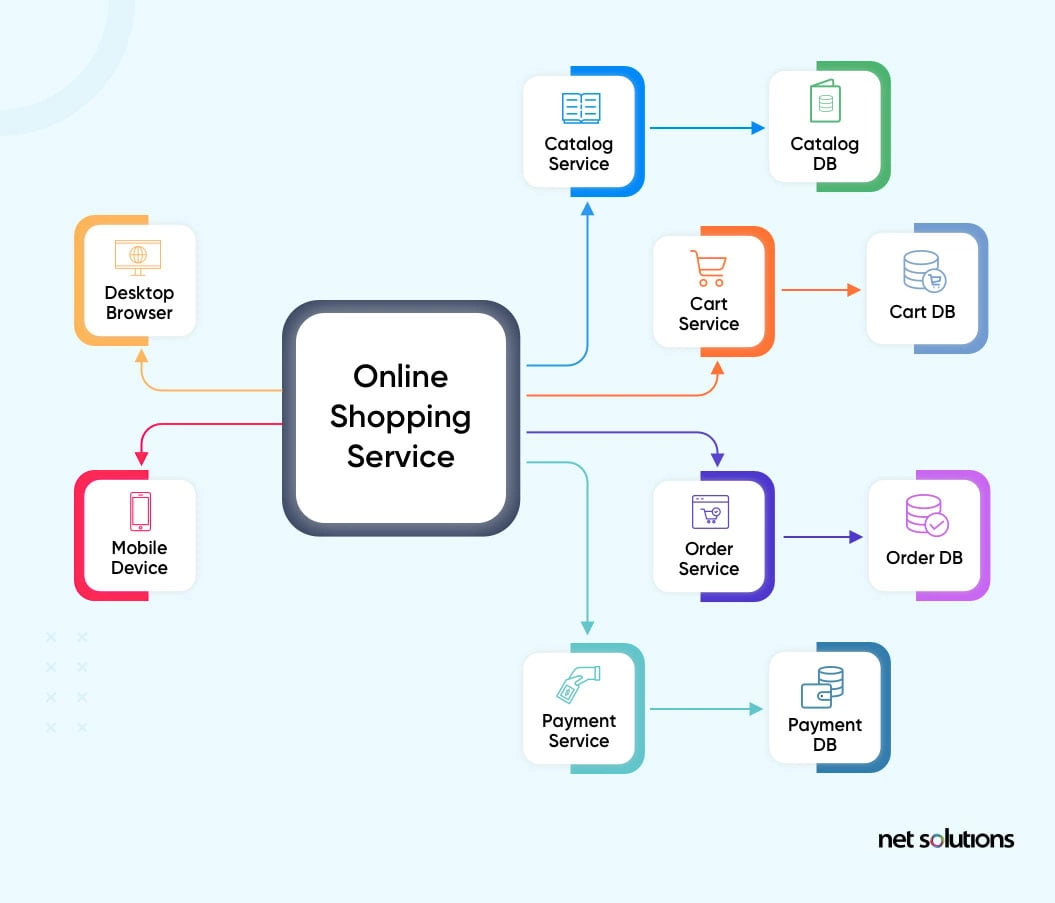
The user accesses the user interface, which connects to each microservice independently when and only when needed. If the website suddenly sees a lot of traffic, the catalog service can be scaled up, with other microservices being scaled as much or as little as needed.
Microservices vs. SOA Architecture
Service-oriented architecture (SOA) is another modular architecture, but one that leverages “services” – data as a service (DaaS), software as a service (SaaS), and platform as a service (PaaS). The most significant difference between microservices and the SOA model comes down to communication: in microservices, services are independent services, whereas, in SOA, the services can communicate with each other to support the app, sometimes coordinating activities.
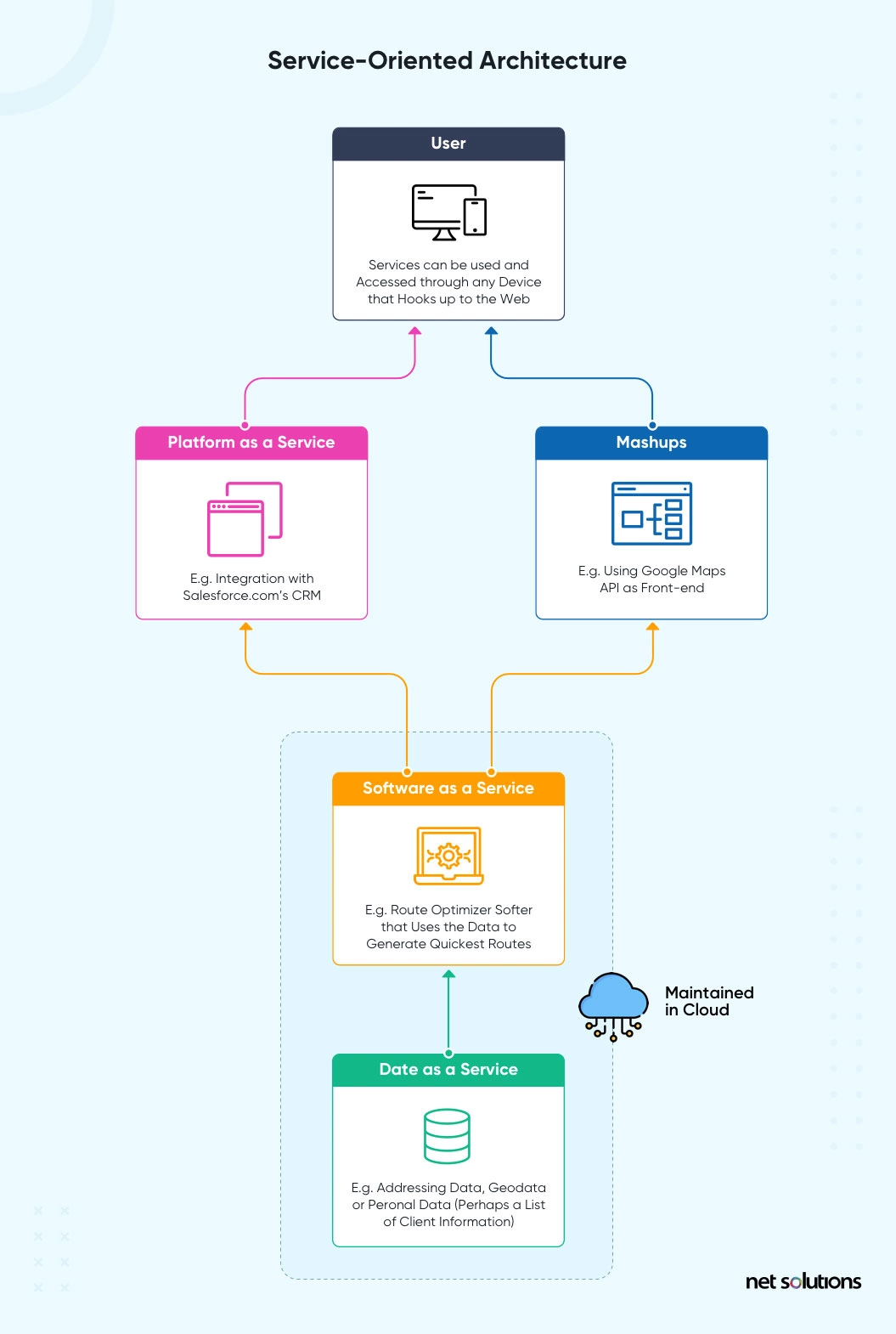
Advantages of the Microservices Architecture
Here are the benefits of a microservices architecture that solve many of the main problems with monolithic architecture:
- Since you can scale each service independently of others, organizations can handle high traffic and spikes in usage more efficiently in the microservice architecture.
- Organizations can quickly and easily add new features and services in the microservices architecture, making adapting to changing business requirements easier.
- Microservices architecture is resilient to failures, as each service operates independently of others, reducing the risk of cascading losses and enabling faster recovery.
- Maintaining the microservices architecture is more accessible than monolithic architecture, as each service is separate and independent, making modifying, updating, and testing individual services easier.
- Microservices architecture is flexible, allowing organizations to use different technologies and programming languages for each service based on their specific needs.
- Teams can work independently on specific services in the microservices architecture, reducing coordination overhead and increasing team autonomy.
- Microservices architecture can be cost-effective, enabling organizations to use different infrastructures and resources for each service, optimizing costs, and reducing overall expenses.
- Components are only loosely coupled by API in the microservice architecture, with fewer interdependencies, making updating or replacing a module easier.
- Microservices architecture enables continuous deployment, as you can deploy and test each service independently, reducing the time required to release new features and updates.
- Module code base makes it easier for developers to learn each module, find bugs, or make microservice architecture changes.
- Development is accelerated by the ability to reuse code, choose robust technologies and frameworks, and support iterative development.
- Each microservice can use the technology stack best for its operations in the microservice architecture.
Disadvantages of Microservices Architecture
While the advantages of microservices architecture seem obvious, like any other choice, there are always drawbacks. The disadvantages of microservices architecture include the following:
- A microservice architecture can be more complex to design, implement, and maintain than a monolithic architecture. With a more significant number of services, there are more components to manage, making it harder to understand the system as a whole.
- Since microservices are distributed systems, they can suffer from latency, network failures, and synchronization problems.
- With more services to manage, the Microservice architecture has an increased operational overhead. It can include service discovery, load balancing, and deployment tasks.
- In a microservice architecture, services need to communicate with each other over a network, which can add communication overhead.
- Testing microservices can be more complex than testing a monolithic architecture. With more services to experiment with, there are more integration points and scenarios to consider.
- As the number of services increases, dependency management becomes more challenging. Managing dependencies between services can be difficult, and versioning can be challenging.
- Implementing a microservice architecture can be more expensive than a monolithic architecture. It is because there are more components to manage, and there may be a need for additional infrastructure and tooling.
- Since you need IT skills for each microservice, talent shortage can be an issue when so many frameworks and technologies are in use.
- Microservices require more oversight in monitoring and logging each microservice.
- A microservice architecture also requires more oversight to address security.
- It can be challenging to decide where each module begins and ends in the microservice architecture as not all “components” are easy to define.
- Moving code across microservices can be complicated as you use different technologies.
Monolithic Architecture vs. Microservices Architecture: A Comparison
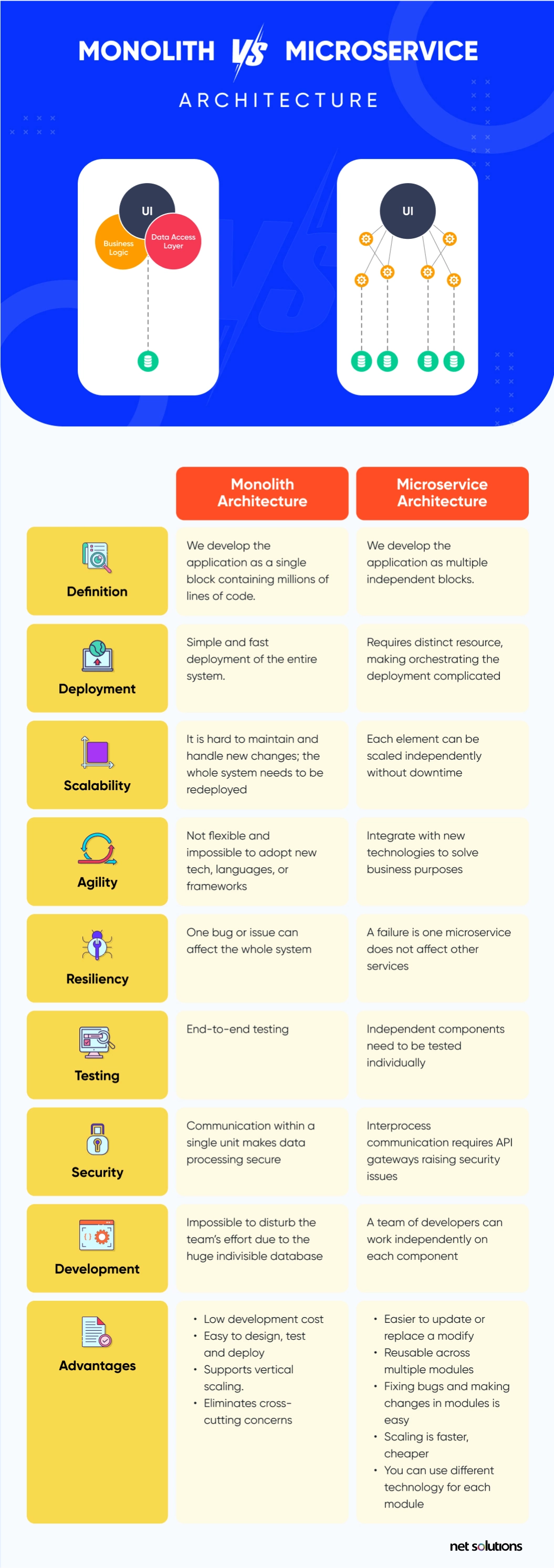
Now that this guide has introduced monolithic and microservices architecture, the following sections will compare and contrast the two regarding strategy, features, and how to choose between the two.
Monolithic vs. Microservices Diagram
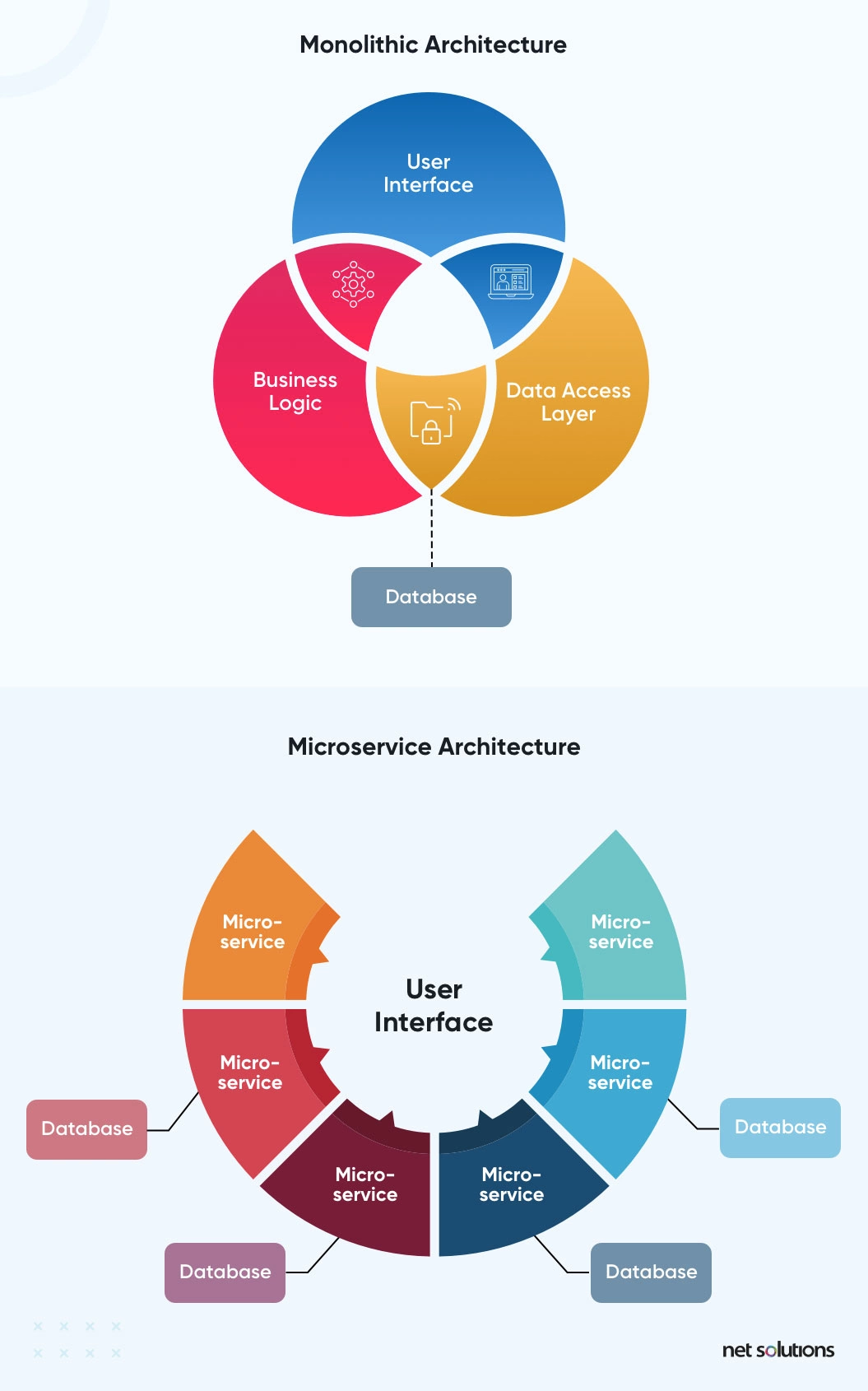
Microservices vs. Monolithic Architecture: Deployment Strategy
While it is more evident that monolithic architecture (one code base) deploys in a traditional format to standard web servers, you cannot say the same for microservices architecture. Various approaches can support microservices deployment, including
- One service-One host: Deploy each service to just one virtual machine (host). It is the lowest cost and most straightforward option.
- One Service-One Container: Docker containers help to isolate microservices (one of the goals of good strategy) but allow those containers to share resources such as operating servers, libraries, or frameworks.
- Serverless Deployment: Serverless deployments abstract and outsourced infrastructure. While the program created will run on a server, the servers are hosted and managed entirely by a third party (Cloud) that worries about all the patching, scaling, and load tasks.
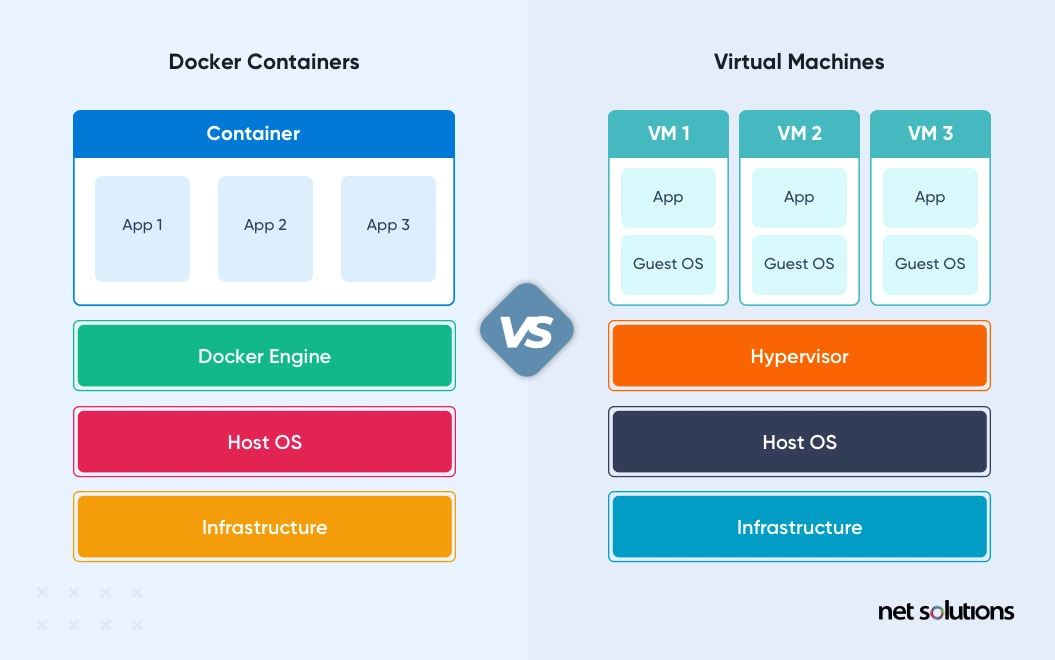
Monolithic Architecture vs. Microservices Architecture: What’s the Difference?
| Deployment | Simple and fast deployment of the entire system | Requires distinct resource, making orchestrating the deployment complicated |
| Scalability | It is hard to maintain and handle new changes; the whole system needs to be redeployed | Each element can be scaled independently without downtime |
| Agility | Not flexible and impossible to adopt new tech, languages, or frameworks | Integrate with new technlogies to solve business purposes |
| Resiliency | One bug or issue can affect the whole system | A failure is one microservice does not affect other services |
| Testing | End-to-end testing | Independent components need to be tested individually |
| Security | Communication within a single unit makes data processing secure | Interprocess communication requires API gateways raising security issues |
| Development | Impossible to disturb the team’s effort due to the huge indivisble database | A team of developers can work independently on each component |
How to Migrate from a Monolith to a Microservices architecture?
Here are the steps to migrate from a monolithic architecture to a microservices architecture:
Step 1. Understand your current system.
Before you start migrating, you must clearly understand your current monolithic system. Identify the different components, their dependencies, and their data flow. It will help you decide which parts you can separate into Microservices.
Here are three main information components you need to identify in your current system:
- Data objects: Logical constructs representing the data you’re using.
- Data actions: Commands to perform tasks in one or more data objects.
- Job to perform: Specific actions a user wants to achieve. You can represent these jobs through user stories or use cases.
When combining these multiple systems into a unified approach, you need to identify the data objects, data actions, and jobs to perform for each system. We employ these components as modules within the codebase, where each module represents each data object, data action, and job to accomplish. Then, you need to further group these modules into categories, as indicated by the color coding in the image below:
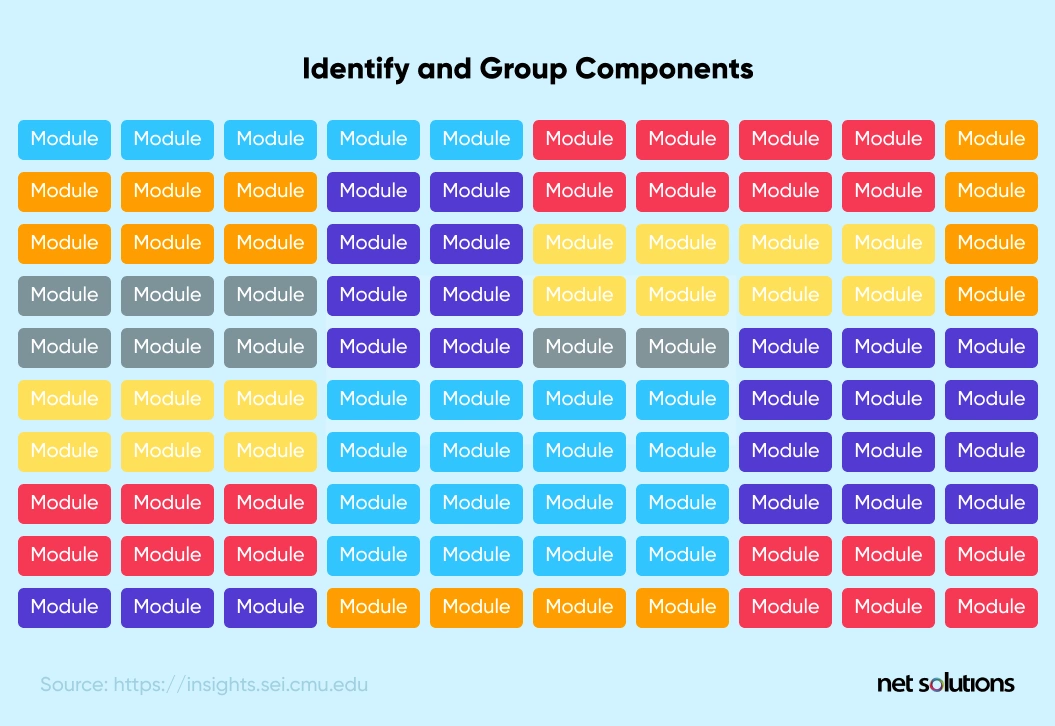
Step 2: Flatten and Refactor Components
After identifying and grouping the modules, the next step is to organize the groups internally. The idea is to identify and address duplicate functionality before implementing the microservice. Ultimately, the system should follow the single-responsibility principle, i.e., only one microservice should perform a specific function.
If you encounter duplicate functions in your system, here are a few things you must consider:
- Check data formats and verify data types.
- Verify data accuracy and data units.
- Identify outliers.
- Deal with missing fields or values.
Step 3: Identify Component Dependencies
Once you have identified, grouped, and prioritized components for migration – the step is to identify dependencies between them. You can perform this in two ways:
- Using static code analysis to search for calls between different data types and libraries.
- Using dynamic analysis tools like SonarGraph-Explorer to analyze the application’s usage pattern during execution. It would provide an automated map between components.
Here’s an image showcasing dependencies between components:
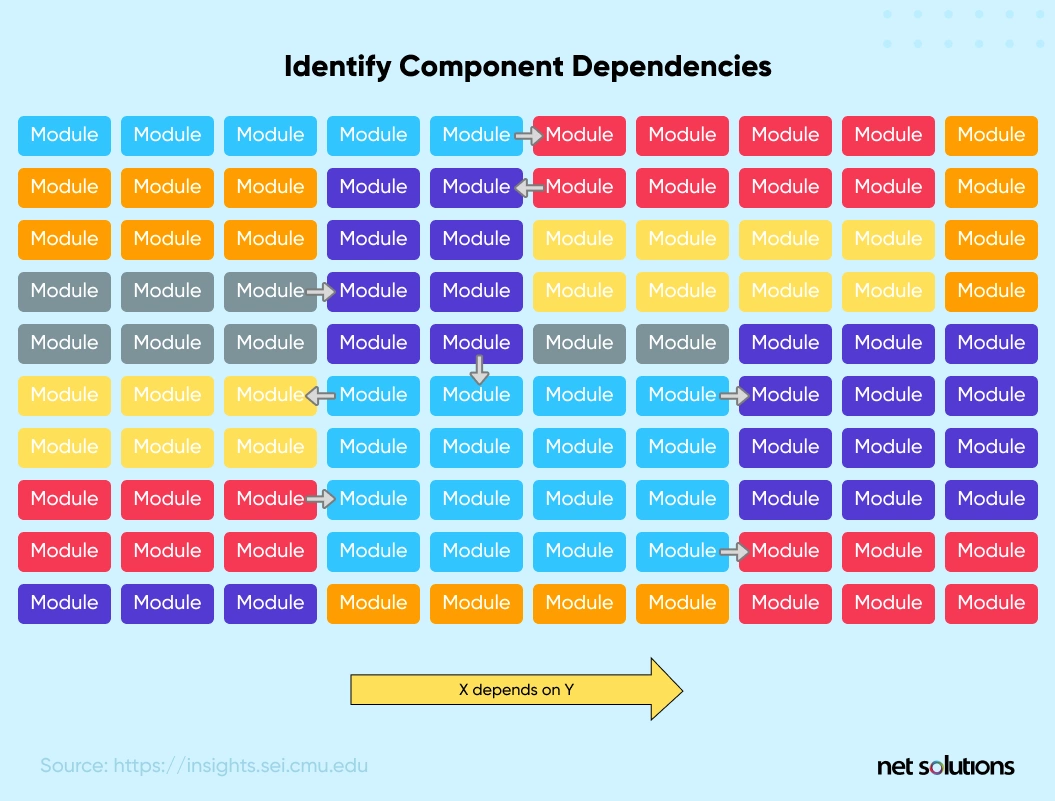
Step 4: Identify Component Groups
The next step is to combine components into cohesive groups that you can quickly transform into Microservices or macroservices (a slightly larger version of Microservices).
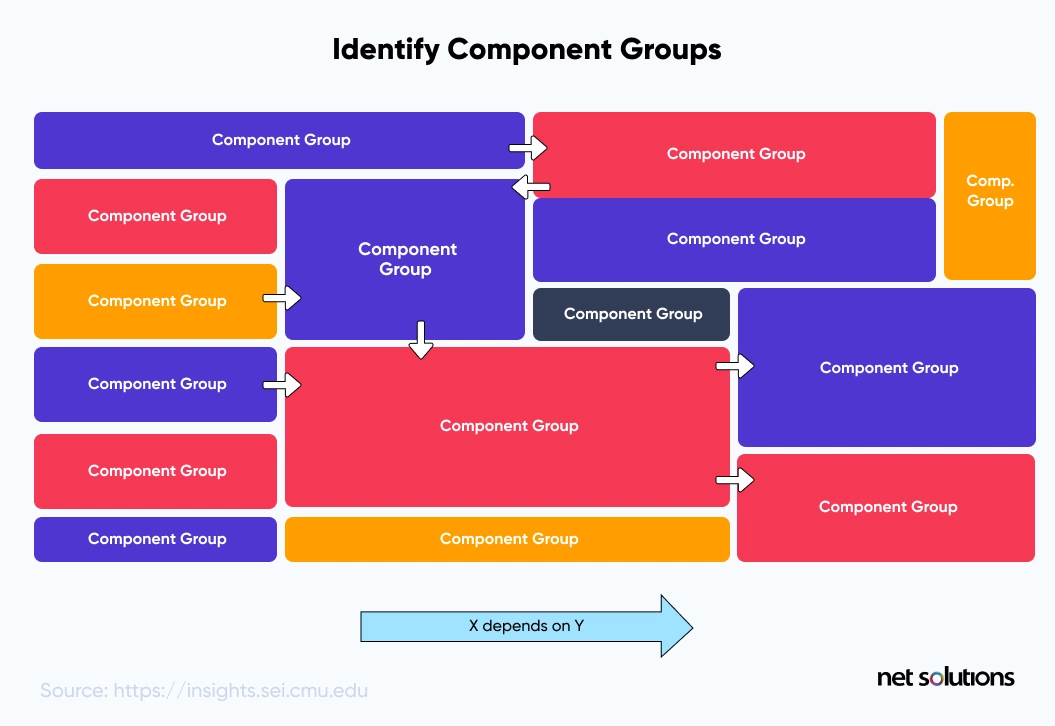
Step 5: Create an API for Remote User Interface
Since Microservices are independent, they can’t communicate with each other. Hence, it would be best to have a remote user interface that would act as the sole medium of communication between the components of each module. For this, you must create an API that the user interface and modules can use to communicate and manipulate data.
To ensure seamless communication between the modules, ensure that the API is:
- Stateless
- Versioned
- Capable of handling all data objects represented within the system
- Compatible with all previous versions
Step 6: Migrate Component Groups to Macroservices
Macroservices are slightly larger versions of Microservices. They’re more like an interim step between a monolith and microservice architecture that allows more complex interactions with data objects. We don’t migrate directly to Microservices because monolith applications are built with intertwined logic, and relocating them directly can be too complicated.
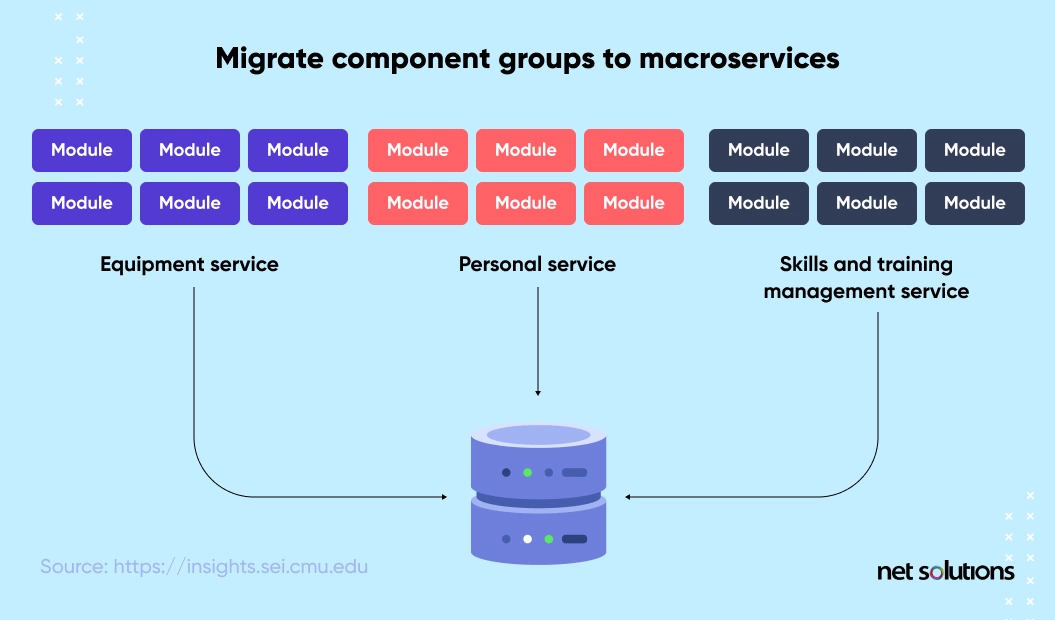
While migrating component groups into macroservices, ensure each macroservice is independently deployable from within the system’s continuous integration (CI) and deployment (CD) pipeline.
Step 7: Migrate Macroservices to Microservices
The next step is to break down macroservices into Microservices further. While migratinAg, ensure that each microservice is independently deployable and scalable.
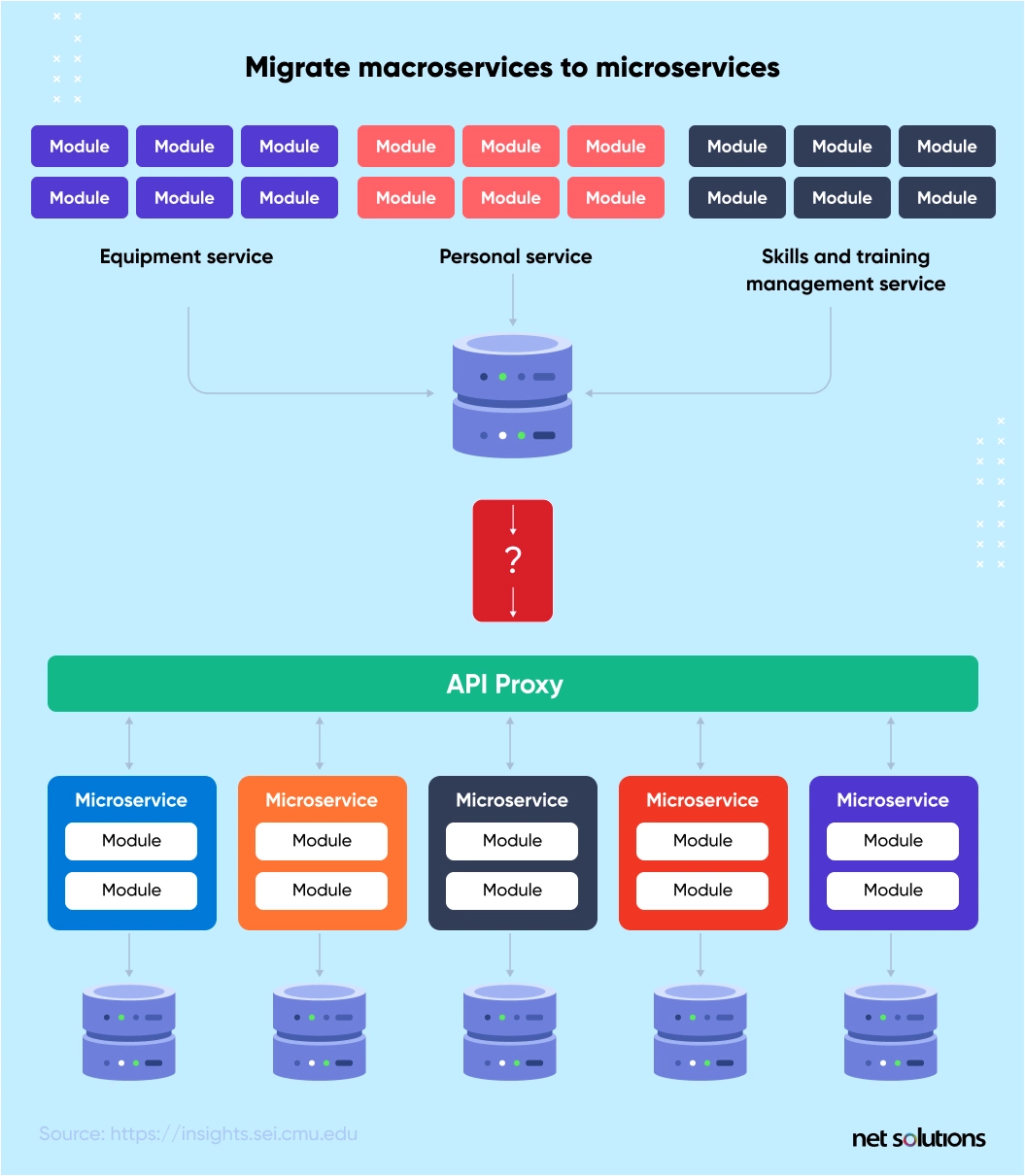
Here’s how the application will look once you’ve fully converted it from monolith to microservice architecture:

Step 8: Deployment and Testing
When the macroservice or microservice is ready, test it thoroughly to ensure it performs as expected. Use automated testing as much as possible to speed up the testing process. Once the Microservices are tested and ready, integrate them with the rest of the system. Finally, deploy the Microservices. However, monitor the microservices closely to ensure they are performing as expected. Use monitoring tools like Datadog, Prometheus, and AWS CloudWatch to quickly identify and resolve any issues.
Monolithic Architecture vs. Microservices Architecture: Which One You Should Choose?
Can’t decide which software architecture is best for your organization and project? Let’s examine why you should choose a monolithic architecture and why you should choose a microservices architecture.
Choosing a Monolithic Architecture
Choose monolithic architecture if the organization or project involves:
- Small Team: Monolithic architecture is ideally suited to small businesses or startups. With a lean IT team, you can have deep experience in one technology stack for the entire application and not worry about skill shortages for different IT stacks, knowledge silos, or the ongoing management of more complex microservice architecture.
- Simple Application: There is no need to reinvent the wheel for a simple, straightforward application that will not likely scale at an unprecedented pace.
- No Microservices Expertise: Effective microservices require multiple people with expertise in specific services, technologies, or frameworks, as well as those with experience in bringing it all together to work well.
- Quick Launch: You can develop a simple application to prototype rapidly with a monolithic approach.
Choosing a Microservices Architecture
Conversely, monolithic architecture is not ideally suited where organizations must remain agile against competition and resources are at play to develop a large or complex app.
- A Complex and Scalable Application: Microservices will help the organization develop more complex software or apps that involve a lot of business logic (operated by many different modules), either offering personalization or lots of features or heavy use of interactivity. Microservices are also ideally suited for those “breakthrough” startup apps or apps that reach a large audience and need to be able to scale rapidly.
- Microservices Expertise: If the team has access to or can hire the right skills and knowledge, it’s possible to aim for a microservices approach to build and maintain an app built on microservices architecture. IT teams need experience in microservices, DevOps, containers, and Cloud.
- Enough Engineering Skills: Microservices teams require enough in-house or outsourced skills in enough areas to develop each module/tech stack or to work with SaaS options for different modules.
- Excellent Cloud-based Infrastructure: Microservices rely on Cloud infrastructure to be effective and to scale appropriately (at the right speed and cost) as necessary. Ensure the cloud infrastructure chosen is flexible on pay and technology to provide the greatest flexibility in architecture.
Frequently Asked Questions
The choice to start with a microservice or a monolith (monolithic) comes down to the team’s size and skill, the program’s needs, and the desired time to market. While most conventional wisdom would suggest a small or startup team leverage a monolithic approach, outsourcing can help small teams future-proof their big ideas with a microservices system.
No, each microservice can have its tech stack, allowing developers to choose the right technology, frameworks, and libraries ideally suited for each module.
Simple monolithic applications are simple to develop, debug and deploy, but over time they can become difficult to scale and suffer from performance issues. On the other hand, the independent scaling capabilities of a microservices architecture make it ideal for high-performance situations. Still, the number of API calls can drain performance, making this a ‘push’ situation.
From a development standpoint, ‘speed’ depends on the team. Microservices architecture is well suited to iterative, incremental development where sprints can focus on modules and accelerate time to market.
Amazon has developed a sophisticated microservices infrastructure to support its vast array of services and products. It has allowed them to maintain a high service availability and reliability, even handling millions of requests per second across its various services.

